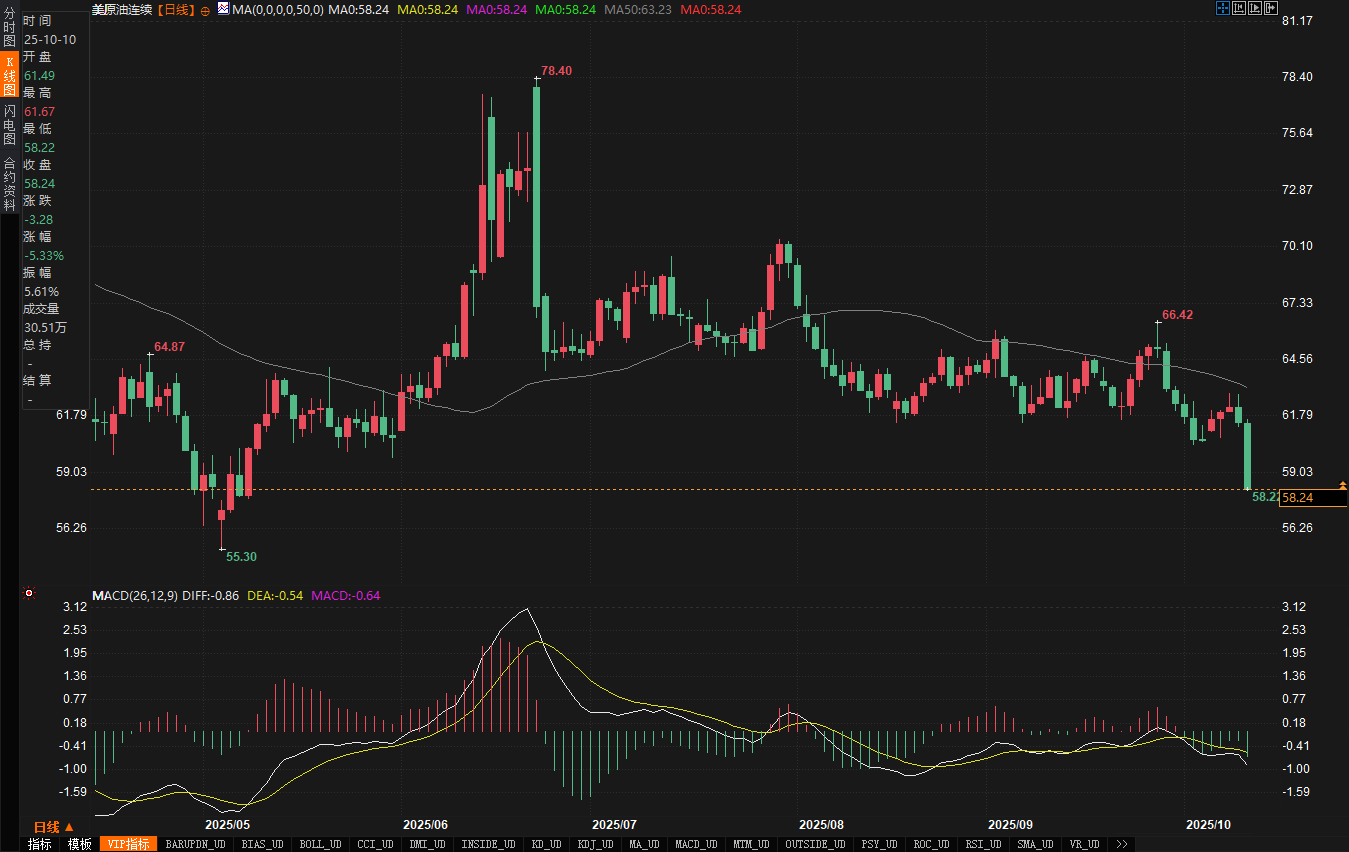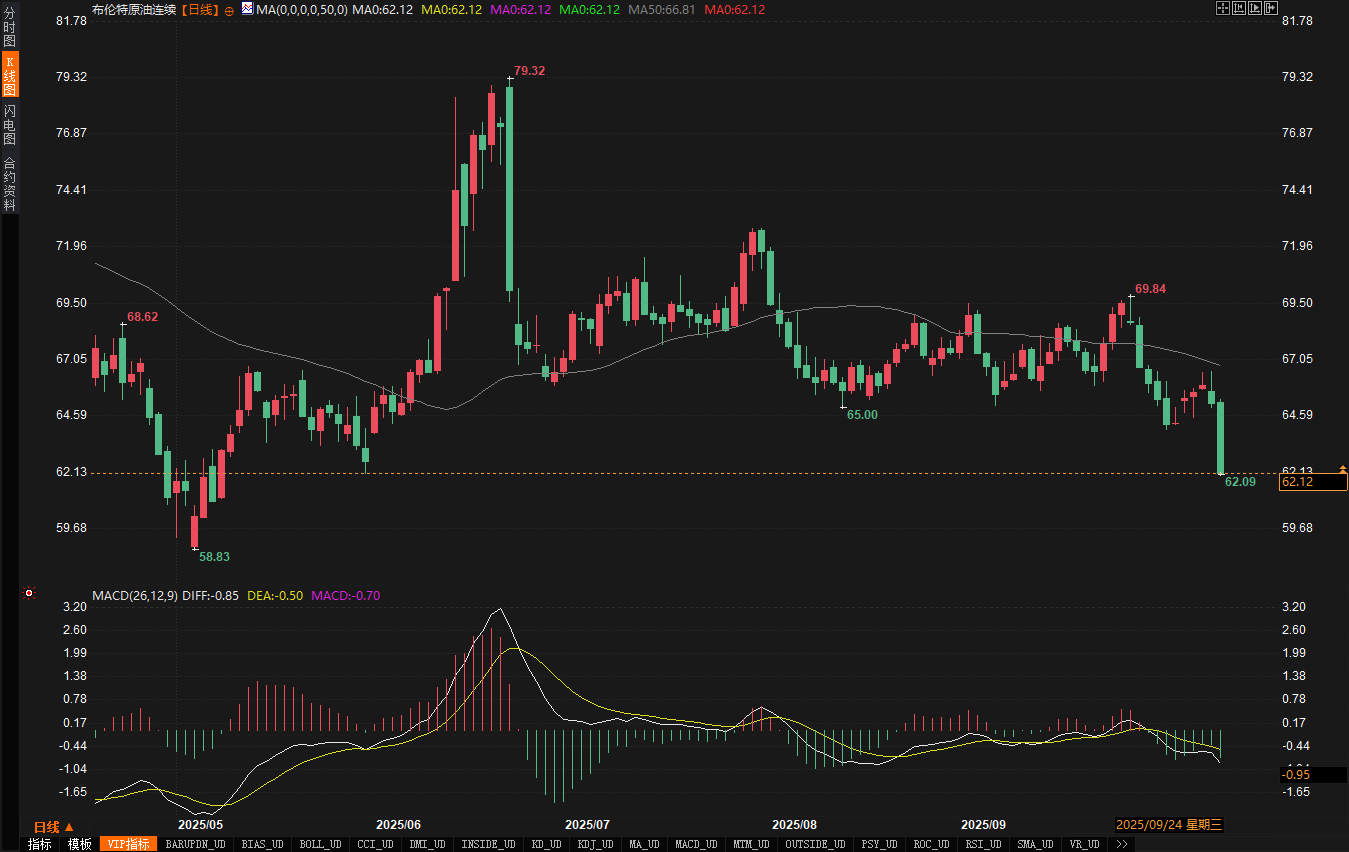International Crude Oil Market Weekly Review: Gloomy demand outlook coupled with supply concerns pushes oil prices to a five-month low
2025-10-11 16:28:55

Review of crude oil market trends this week
During the week of October 6 to October 11, 2025, international crude oil prices generally showed a weak downward trend, with sharp drops recorded over the weekend. Among them, the sell-off on Friday was particularly eye-catching.
Brent crude oil futures contracts saw significant declines this week, with a particularly sharp drop of 4.67% at Friday's close, ultimately settling at $65.16 per barrel. This price is the lowest Brent crude oil has reached since May of this year.
The decline in the U.S. crude oil (WTI) contract was even more severe, reflecting the North American market's pessimistic outlook on short-term demand. WTI prices plummeted 5.33% on Friday, closing at $61.52 per barrel. During the session, WTI prices briefly fell below the psychologically important $60 mark, reaching a low of $58.22 per barrel, signaling the spread of market panic and the rapid unwinding of long positions.
Judging from the technical chart (as shown in the attached figure), the sharp drop in oil prices broke the previous few months' range of fluctuations, and technical indicators such as MACD weakened rapidly, showing that market sentiment has shifted from balanced to clearly bearish.


Major market-moving events and economic data
The sharp pullback in crude oil prices this week was not caused by a single factor, but was the result of the interaction of multiple macroeconomic and geopolitical events.
1. Tariff threats and concerns about demand outlook (impact of Trump's policies)
The most direct and primary catalyst for this sell-off was US President Trump's threat of a new round of tariffs, which quickly triggered a surge in risk aversion in financial markets, particularly for crude oil, a commodity closely tied to global trade and economic activity.
Markets are generally concerned that the US government's protectionist trade measures will further weaken global economic growth and ultimately dampen demand in the world's largest crude oil consumer. With the crude oil market already facing a potential oversupply, any signal of a weakening demand outlook will be amplified, triggering a chain reaction.
2. Geopolitical Risk Ease: A significant risk premium has been eliminated in the Middle East. Israel and the Palestinian militant group Hamas signed a ceasefire agreement on Thursday, the first phase of the US President's initiative to end the Gaza conflict. The market interpreted this ceasefire agreement as a significant easing of geopolitical risk. The geopolitical uncertainty premium that had previously supported oil prices quickly dissipated, prompting investors to refocus on supply and demand fundamentals.
Furthermore, while not directly impacting Middle Eastern oil-producing regions, market sentiment remains sensitive to ongoing geopolitical tensions in Eastern Europe. Traders are closely monitoring developments in the region, and while this continued risk aversion has somewhat dampened large-scale long positions, its boost to oil prices is less pronounced than before.
3. Increased global supply and OPEC's production policy. The increase in crude oil supply is a structural factor that continues to suppress oil prices. First, the Organization of the Petroleum Exporting Countries (OPEC) is gradually withdrawing from its previous production cuts, and its production is slowly recovering. Second, additional supply growth from non-OPEC oil-producing countries such as North and South America continues to flood the market. This has caused the previously balanced market structure to shift towards ample supply, or even oversupply.
Investors are also wary of domestic political uncertainty. Concerns about a prolonged government shutdown have fueled market concerns that the US economy, the world's largest crude oil consumer, could be weakened. While not directly related to economic data, this macroeconomic uncertainty has exacerbated pessimistic forecasts for the US crude oil demand outlook.
Summary of analysts and institutions' views
Senior market analysts and major financial institutions have expressed their views on this week's plunge in oil prices and the factors driving it, focusing primarily on deteriorating demand expectations and concerns about oversupply:
UBS
UBS analyst Giovanni Staunovo said the current sell-off in the crude oil market was directly triggered by US President Trump's new round of tariff threats, which quickly triggered a surge in risk aversion. This suggests that macroeconomic policy risks are clearly playing a dominant role in short-term oil price trends.
Lipow Oil Associates
Andrew Lipow, president of Lipow Oil Associates, noted that Friday's decline was the result of a combination of factors, with the US President's threat of significant tariff increases being just the latest trigger. He emphasized that the tariff threat, coupled with OPEC's production increases, the continued growth of additional supply from North and South America, and the easing of geopolitical risks following the Gaza ceasefire agreement, all contribute to the bearish market logic.
Australia and New Zealand Banking Group (ANZ)
ANZ analyst Daniel Hynes believes that with the signing of the Gaza ceasefire agreement, the market's focus is rapidly shifting back to the impending oil oversupply. He added that as OPEC is gradually withdrawing from its previous production cuts, supply-side pressure will become the key variable dominating oil price trends for some time to come.
Market outlook for next week
This week's dramatic performance in the crude oil market clearly signaled that global crude oil pricing is shifting away from geopolitical risk premiums and toward supply and demand fundamentals driven by the global trade environment. The sharp drop in prices to a new five-month low this week stems from the fact that the US President's protectionist trade measures have significantly worsened expectations for global economic growth and crude oil demand.
The market is balancing the following key contradictions: on the one hand, the gradual return of production from OPEC and its allies, coupled with continued increases in non-OPEC production; on the other hand, the risk of slowing demand growth in the world's largest economies due to political uncertainty and trade tensions. Looking ahead to next week, investors will continue to monitor the progress of trade negotiations between major global economies, the resolution of the US government shutdown risk, and any further signals from OPEC regarding current price trends.
Against the backdrop of an uncertain demand outlook and steadily rising supplies, oil prices are likely to remain under pressure in the short term unless there are new, strong supply disruptions.
- Risk Warning and Disclaimer
- The market involves risk, and trading may not be suitable for all investors. This article is for reference only and does not constitute personal investment advice, nor does it take into account certain users’ specific investment objectives, financial situation, or other needs. Any investment decisions made based on this information are at your own risk.





















